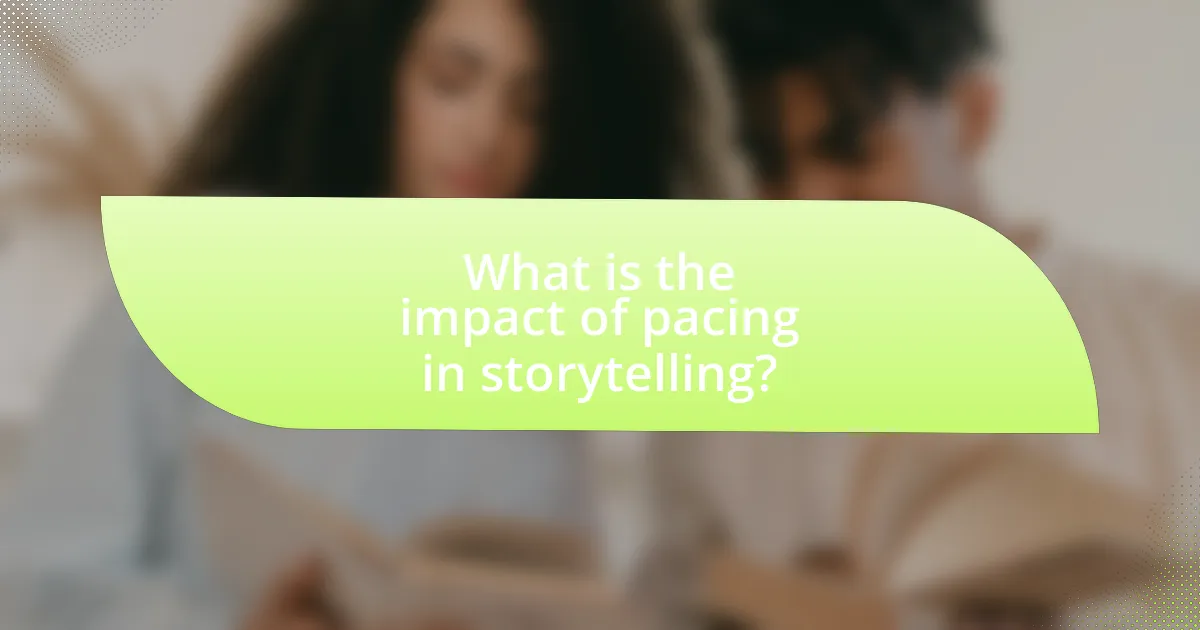The article focuses on the impact of pacing in storytelling, emphasizing its crucial role in shaping emotional engagement and narrative tension. It explores how varying pacing influences reader experience, character development, and plot progression, highlighting techniques such as sentence length, dialogue, and scene breaks to control the flow of a narrative. Additionally, the article examines genre-specific pacing expectations and provides practical tips for authors to enhance pacing, maintain reader interest, and identify pacing issues through feedback. Overall, it underscores the importance of effective pacing as a fundamental element in successful storytelling.

What is the impact of pacing in storytelling?
Pacing in storytelling significantly influences the emotional engagement and narrative tension experienced by the audience. Effective pacing controls the rhythm of the story, determining how quickly or slowly events unfold, which can heighten suspense or allow for deeper character development. For instance, a study by the University of Southern California found that varying pacing can lead to increased viewer retention and emotional response, as audiences are more likely to remain engaged during moments of tension and conflict. Thus, pacing is a critical tool for storytellers to shape the audience’s experience and maintain interest throughout the narrative.
How does pacing influence the reader’s experience?
Pacing significantly influences the reader’s experience by controlling the speed at which a narrative unfolds, thereby affecting engagement and emotional response. When pacing is varied, it can create tension during fast-paced scenes, enhancing excitement, while slower pacing allows for deeper character development and reflection. Research indicates that readers often feel more immersed in a story when pacing aligns with their emotional investment; for instance, a study published in the Journal of Experimental Psychology found that readers’ emotional responses are heightened during rapid plot developments compared to slower, more descriptive passages. This demonstrates that effective pacing not only shapes the narrative flow but also directly impacts how readers connect with the story and its characters.
What are the different types of pacing in narratives?
The different types of pacing in narratives include fast pacing, slow pacing, and variable pacing. Fast pacing accelerates the narrative flow, often used in action scenes or climactic moments to create urgency and excitement. Slow pacing allows for detailed exploration of characters, settings, or themes, often found in reflective or emotional scenes. Variable pacing combines both fast and slow elements, providing a dynamic rhythm that can enhance tension and engagement throughout the story. Each type serves a specific purpose in shaping the reader’s experience and emotional response.
How does pacing affect emotional engagement in a story?
Pacing significantly affects emotional engagement in a story by controlling the rhythm at which events unfold, thereby influencing the audience’s emotional responses. When pacing is well-managed, it can heighten tension during critical moments, allowing readers to feel suspense or excitement, while slower pacing can create a sense of reflection or intimacy, fostering deeper emotional connections with characters. Research indicates that stories with varied pacing, such as alternating between fast-paced action and slower, contemplative scenes, can enhance emotional engagement by keeping the audience invested and responsive to the narrative’s emotional shifts. For instance, a study published in the Journal of Experimental Psychology found that readers reported higher emotional engagement when stories employed a mix of pacing strategies, demonstrating the importance of pacing in shaping emotional experiences.
Why is controlling the flow of a story important?
Controlling the flow of a story is important because it directly influences the reader’s engagement and emotional response. Effective pacing allows a narrative to build tension, develop characters, and maintain interest, ensuring that key moments resonate with the audience. Research indicates that stories with well-managed pacing can enhance comprehension and retention, as demonstrated in studies on narrative structure and reader engagement. For instance, a study published in the Journal of Educational Psychology found that students who read stories with varied pacing performed better on comprehension tests than those who read stories with monotonous flow. This evidence underscores the significance of pacing in storytelling, as it shapes the overall impact and effectiveness of the narrative.
What role does pacing play in plot development?
Pacing is crucial in plot development as it dictates the speed at which a story unfolds, influencing the audience’s emotional engagement and tension. Effective pacing allows for a balance between action and reflection, ensuring that key moments resonate with the audience while maintaining narrative momentum. For instance, a study by the University of Southern California found that varying pacing can enhance viewer retention and emotional response, demonstrating that well-timed slow and fast sequences can significantly impact audience engagement.
How can pacing enhance character development?
Pacing enhances character development by controlling the timing and rhythm of a story, allowing for deeper emotional engagement and growth. When pacing is carefully managed, it creates opportunities for characters to experience significant moments that lead to transformation, such as conflicts, revelations, or relationships. For instance, a slower pace during critical character moments can allow readers to fully absorb the emotional weight of a character’s decisions, fostering a stronger connection. Conversely, a faster pace can heighten tension and urgency, pushing characters to react and evolve quickly, which can reveal their true nature. Studies in narrative theory indicate that pacing directly influences reader perception and emotional response, thereby impacting how characters are perceived and developed throughout the story.

What techniques can be used to control pacing?
Techniques to control pacing include varying sentence length, using dialogue, and employing scene breaks. Varying sentence length creates rhythm; shorter sentences can quicken the pace, while longer sentences can slow it down, allowing for reflection. Dialogue naturally speeds up pacing by creating a sense of immediacy and engagement. Scene breaks can also control pacing by providing pauses, allowing readers to absorb information before moving on to the next action or event. These techniques are widely recognized in narrative structure and storytelling, as they directly influence how readers experience the flow of a story.
How can sentence structure affect pacing?
Sentence structure significantly affects pacing by influencing the rhythm and speed at which a reader processes the text. Short, simple sentences create a quick pace, often used in action scenes to generate urgency, while longer, complex sentences slow down the reading experience, allowing for reflection and detail. For example, in literature, authors like Ernest Hemingway utilize short sentences to convey tension, while Virginia Woolf employs longer, flowing sentences to evoke introspection. This variation in sentence structure directly impacts how quickly or slowly a narrative unfolds, shaping the reader’s emotional response and engagement with the story.
What are the effects of short sentences versus long sentences?
Short sentences create a sense of urgency and clarity, while long sentences often convey complexity and depth. The use of short sentences can enhance readability and maintain the reader’s attention, making them effective in fast-paced narratives. Conversely, long sentences allow for more detailed descriptions and nuanced ideas, which can enrich the storytelling experience. Research indicates that short sentences can improve comprehension, particularly in younger readers, as shown in studies by the National Reading Panel, which emphasize the importance of sentence length in reading fluency.
How does dialogue contribute to pacing?
Dialogue contributes to pacing by creating rhythm and momentum in a narrative. When characters engage in dialogue, the exchange can quicken the pace by delivering information rapidly, heightening tension, or advancing the plot efficiently. For instance, short, snappy exchanges can create urgency, while longer, more reflective conversations can slow down the narrative, allowing for character development or thematic exploration. Studies in narrative structure indicate that well-placed dialogue can significantly influence reader engagement and emotional response, thereby affecting the overall pacing of the story.
What narrative devices can influence pacing?
Narrative devices that can influence pacing include sentence length, chapter structure, and dialogue. Short sentences and paragraphs can create a sense of urgency, while longer, more descriptive passages can slow down the narrative to build tension or develop characters. Additionally, the use of cliffhangers at the end of chapters can compel readers to continue, effectively quickening the pace. Studies in narrative theory indicate that varying these elements strategically can significantly impact reader engagement and the overall flow of the story.
How do flashbacks and foreshadowing impact pacing?
Flashbacks and foreshadowing significantly impact pacing by altering the narrative flow and emotional engagement of a story. Flashbacks can slow down pacing by introducing past events that provide context or backstory, allowing readers to understand characters’ motivations and experiences. For instance, a flashback may pause the current action to delve into a character’s traumatic past, creating a deeper emotional connection and enhancing the stakes of the present narrative. Conversely, foreshadowing accelerates pacing by hinting at future events, generating anticipation and tension. This technique keeps readers engaged, as they become eager to see how the hinted events will unfold. For example, a subtle clue about a character’s impending betrayal can create suspense, prompting readers to read faster to uncover the outcome. Together, these techniques manipulate pacing by balancing moments of reflection with forward momentum, ultimately shaping the reader’s experience and emotional investment in the story.
What is the role of scene length in pacing control?
Scene length plays a crucial role in pacing control by influencing the rhythm and flow of a narrative. Short scenes can create a sense of urgency and speed, propelling the story forward quickly, while longer scenes allow for deeper character development and more intricate plot details, thereby slowing the pace. Research indicates that varying scene lengths can effectively manipulate reader engagement; for instance, a study published in the Journal of Narrative Theory highlights how rapid scene changes can heighten tension, while extended scenes can enhance emotional resonance. Thus, the strategic use of scene length is essential for maintaining the desired pacing throughout a story.

How can pacing be adjusted for different genres?
Pacing can be adjusted for different genres by varying the speed and rhythm of the narrative to align with genre conventions. For instance, in thrillers, short sentences and rapid scene changes create urgency, while in literary fiction, longer, more descriptive passages allow for deeper character exploration and thematic development. Research indicates that genre expectations significantly influence reader engagement; for example, a study published in the Journal of Experimental Psychology found that readers of suspenseful narratives prefer faster pacing to maintain tension. Thus, understanding genre-specific pacing techniques is crucial for effective storytelling.
What are the pacing expectations in various genres?
Pacing expectations vary significantly across genres, influencing how stories are structured and experienced. In thrillers, rapid pacing is essential, often characterized by short chapters and cliffhangers to maintain tension and urgency. Conversely, literary fiction typically employs a slower pace, allowing for in-depth character development and thematic exploration, often using longer, more descriptive passages.
In romance, pacing balances between quick, emotionally charged moments and slower, reflective scenes to build tension and connection between characters. Science fiction and fantasy often feature a moderate pace, integrating world-building with plot progression, which can lead to longer exposition sections.
Horror relies on a fluctuating pace, alternating between slow build-ups to create suspense and sudden bursts of action to elicit fear. Each genre’s pacing aligns with its thematic goals and audience expectations, shaping the overall narrative experience.
How does pacing differ between thrillers and romances?
Pacing in thrillers is typically fast and urgent, designed to create tension and keep readers on the edge of their seats, while pacing in romances is generally slower and more deliberate, focusing on character development and emotional connection. In thrillers, short chapters, cliffhangers, and rapid plot twists are common techniques that maintain a high level of suspense, as seen in works like “The Girl with the Dragon Tattoo” by Stieg Larsson, where the quick pacing propels the narrative forward. Conversely, romances often employ longer chapters and a gradual build-up of relationships, allowing for deeper exploration of characters’ emotions, as exemplified in “Pride and Prejudice” by Jane Austen, where the pacing allows readers to savor the development of the romantic tension.
What techniques are genre-specific for pacing control?
Genre-specific techniques for pacing control include the use of cliffhangers in thrillers, which create suspense and compel readers to continue, and the incorporation of detailed world-building in fantasy, which can slow pacing to immerse readers in the setting. In romance, alternating perspectives can quicken the pace by providing immediate emotional stakes, while in horror, the gradual buildup of tension through foreshadowing can effectively control pacing to enhance fear. These techniques are validated by genre conventions that dictate reader expectations, ensuring that pacing aligns with the emotional and narrative goals of each genre.
How can authors identify pacing issues in their work?
Authors can identify pacing issues in their work by analyzing the flow of events and the emotional engagement of readers throughout the narrative. They can utilize techniques such as reading their work aloud to gauge the rhythm and speed of the story, as well as soliciting feedback from beta readers to pinpoint sections that feel rushed or drawn out. Additionally, authors can examine the balance between action, dialogue, and description; a disproportionate amount of any one element can disrupt pacing. Research indicates that effective pacing maintains reader interest and emotional investment, highlighting the importance of this analysis in storytelling.
What are common signs of poor pacing in a narrative?
Common signs of poor pacing in a narrative include inconsistent tempo, excessive exposition, and abrupt shifts in action. Inconsistent tempo occurs when the narrative alternates between overly fast and slow sections, disrupting the reader’s engagement. Excessive exposition can lead to long-winded explanations that stall the plot, causing readers to lose interest. Abrupt shifts in action often confuse readers, as they may struggle to follow the storyline when transitions are not smooth. These elements collectively hinder the narrative flow, making it difficult for readers to remain invested in the story.
How can feedback from beta readers help with pacing adjustments?
Feedback from beta readers can significantly aid in pacing adjustments by providing insights into how the story’s rhythm resonates with readers. Beta readers often highlight sections where the narrative feels rushed or sluggish, allowing authors to identify specific areas that may require reworking. For instance, if multiple beta readers note that a particular chapter drags on, the author can consider condensing scenes or enhancing dialogue to maintain momentum. This feedback is crucial because it reflects the readers’ engagement levels, which can be quantitatively assessed through their emotional responses and attention spans during different parts of the story. By addressing these observations, authors can refine the pacing to create a more compelling and cohesive narrative flow.
What practical tips can improve pacing in storytelling?
To improve pacing in storytelling, writers should utilize techniques such as varying sentence length, incorporating cliffhangers, and balancing dialogue with narrative. Varying sentence length creates rhythm; shorter sentences can quicken the pace during action scenes, while longer sentences can slow it down for reflection or description. Incorporating cliffhangers at the end of chapters or sections keeps readers engaged and eager to continue, effectively maintaining momentum. Balancing dialogue with narrative ensures that scenes do not drag on unnecessarily, allowing for a dynamic flow that keeps the audience invested in the characters and plot. These strategies are supported by narrative theory, which emphasizes the importance of pacing in maintaining reader interest and emotional engagement.
How can writers effectively balance action and exposition?
Writers can effectively balance action and exposition by strategically interspersing descriptive passages with dynamic scenes. This technique allows for character development and world-building without sacrificing narrative momentum. For instance, incorporating brief moments of exposition during action sequences can provide necessary context while maintaining reader engagement. Studies in narrative pacing indicate that alternating between fast-paced action and slower, reflective exposition enhances reader immersion and emotional investment, as seen in successful novels like “The Hunger Games” by Suzanne Collins, where action sequences are often followed by moments of introspection that deepen the story’s impact.
What strategies can be employed to maintain reader interest through pacing?
To maintain reader interest through pacing, authors can employ strategies such as varying sentence length, using cliffhangers, and balancing action with reflection. Varying sentence length creates rhythm and keeps the reader engaged; for instance, short sentences can heighten tension during action scenes, while longer sentences can provide depth in reflective moments. Utilizing cliffhangers at the end of chapters or sections compels readers to continue, as they seek resolution. Additionally, balancing fast-paced action with slower, introspective passages allows for character development and emotional connection, which enhances overall engagement. These strategies are supported by narrative theory, which emphasizes the importance of pacing in sustaining reader interest and emotional investment in the story.
